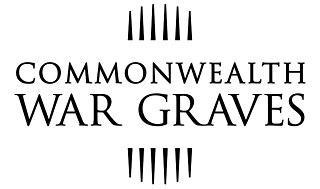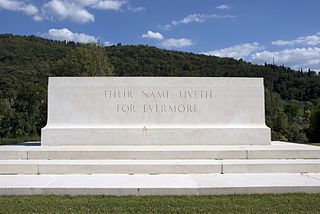
The Commonwealth War Graves Commission (CWGC) is an intergovernmental organisation of six independent member states whose principal function is to mark, record and maintain the graves and places of commemoration of Commonwealth of Nations military service members who died in the two World Wars. The commission is also responsible for commemorating Commonwealth civilians who died as a result of enemy action during the Second World War. The commission was founded by Sir Fabian Ware and constituted through Royal Charter in 1917 as the Imperial War Graves Commission. The change to the present name took place in 1960.

West Norwood Cemetery is a 40-acre (16 ha) rural cemetery in West Norwood in London, England. It was also known as the South Metropolitan Cemetery. One of the first private landscaped cemeteries in London, it is one of the "Magnificent Seven" cemeteries of London, and is a site of major historical, architectural and ecological interest.

The Cross of Sacrifice is a Commonwealth war memorial designed in 1918 by Sir Reginald Blomfield for the Imperial War Graves Commission. It is present in Commonwealth war cemeteries containing 40 or more graves. Its shape is an elongated Latin cross with proportions more typical of the Celtic cross, with the shaft and crossarm octagonal in section. It ranges in height from 18 to 24 feet. A bronze longsword, blade down, is affixed to the front of the cross. It is usually mounted on an octagonal base. It may be freestanding or incorporated into other cemetery features. The Cross of Sacrifice is widely praised, widely imitated, and the archetypal British war memorial. It is the most imitated of Commonwealth war memorials, and duplicates and imitations have been used around the world.


Undercliffe Cemetery is located between Otley Road and Undercliffe Lane in the Bolton and Undercliffe ward, Bradford, West Yorkshire, England. The cemetery stands atop a hillside overlooking the city and contains some very impressive Victorian funerary monuments in a variety of styles. It is a notable example of a Victorian cemetery where a number of rich and prominent local residents have been buried, notably mill owners and former mayors. Undercliffe Cemetery is grade II* listed by English Heritage in their Register of Parks and Gardens of Special Historic Interest in England.

Railway Dugouts Burial Ground (Transport Farm) is a Commonwealth War Graves Commission (CWGC) burial ground for the dead of the First World War located in the Ypres Salient on the Western Front.

Aldershot Military Cemetery is a burial ground for military personnel, or ex-military personnel and their families, located in Aldershot Military Town, Hampshire.

Southern Cemetery is a large municipal cemetery in Chorlton-cum-Hardy, Manchester, England, 3 miles (4.8 km) south of the city centre. It opened in 1879 and is owned and administered by Manchester City Council. It is the largest municipal cemetery in the United Kingdom and the second largest in Europe.

East Finchley Cemetery is a cemetery and crematorium in East End Road, East Finchley. Although it is in the London Borough of Barnet, it is owned and managed by the City of Westminster.

The Stone of Remembrance is a standardised design for war memorials that was designed in 1917 by the British architect Sir Edwin Lutyens for the Imperial War Graves Commission (IWGC). It was designed to commemorate the dead of World War I, to be used in IWGC war cemeteries containing 1,000 or more graves, or at memorial sites commemorating more than 1,000 war dead. Hundreds were erected following World War I, and it has since been used in cemeteries containing the Commonwealth dead of World War II as well. It is intended to commemorate those "of all faiths and none", and has been described as one of Lutyens' "most important and powerful works", with a "brooding, sentinel-like presence wherever used".

Fromelles Military Cemetery is a First World War cemetery built by the Commonwealth War Graves Commission on the outskirts of Fromelles in northern France, near the Belgian border. Constructed between 2009 and 2010, it was the first new Commonwealth War Graves Commission cemetery for more than 50 years, the last such cemeteries having been built after the Second World War. The cemetery contains the graves of 250 British and Australian soldiers who died on 19 July 1916 in the Battle of Fromelles.

Mierlo War Cemetery is a Second World War Commonwealth war grave cemetery, located in the village of Mierlo, 12 km (7.5 mi) east of Eindhoven in The Netherlands.

Founded in 1917, the Ramscappelle Road Military Cemetery is located two kilometers east of the city of Nieuwpoort in the province of West Flanders (West-Vlaanderen), Belgium. It is on the N367, the road which leads from Nieuwpoort to the village of Sint-Joris, near the intersection with Ramscappelle Road (Ramskapellestraat).

Lutwyche Cemetery is a cemetery located at Kedron, Brisbane, Queensland, Australia. It opened in 1878 and saw its first burial in the same year. It is located at the corner of Gympie and Kitchener Roads, approximately ten kilometres north of Brisbane.

Warwick General Cemetery is a heritage-listed cemetery at Wentworth Street, Warwick, Southern Downs Region, Queensland, Australia. It was designed by Dornbusch & Connolly and built from 1853 onwards by Phil Thornton. It was added to the Queensland Heritage Register on 27 April 2001.

Clermont Cemetery is a heritage-listed cemetery at Cemetery Road, Clermont, Isaac Region, Queensland, Australia. It was established in 1866. It was added to the Queensland Heritage Register on 6 August 2010.

Richmond Cemetery is a cemetery on Lower Grove Road in Richmond in the London Borough of Richmond upon Thames, England. The cemetery opened in 1786 on a plot of land granted by an Act of Parliament the previous year. The cemetery has been expanded several times and now occupies a 15-acre (6-hectare) site which, prior to the expansion of London, was a rural area of Surrey. It is bounded to the east by Richmond Park and to the north by East Sheen Cemetery, with which it is now contiguous and whose chapel is used for services by both cemeteries. Richmond cemetery originally contained two chapels—one Anglican and one Nonconformist—both built in the Gothic revival style, but both are now privately owned and the Nonconformist chapel today falls outside the cemetery walls after a redrawing of its boundaries.
Bancourt British Cemetery is a Commonwealth War Graves Commission burial ground for the dead of the First World War located in the Pas de Calais region of France, on the Western Front.

Adelaide River War Cemetery is a heritage-listed cemetery at 105 Memorial Terrace, Adelaide River, Northern Territory, Australia. It was added to the Australian Commonwealth Heritage List on 22 June 2004.

Mailly Wood Cemetery is a military cemetery with casualties from the First World War, located in the French village of Mailly-Maillet (Somme). It is maintained by the Commonwealth War Graves Commission.


























